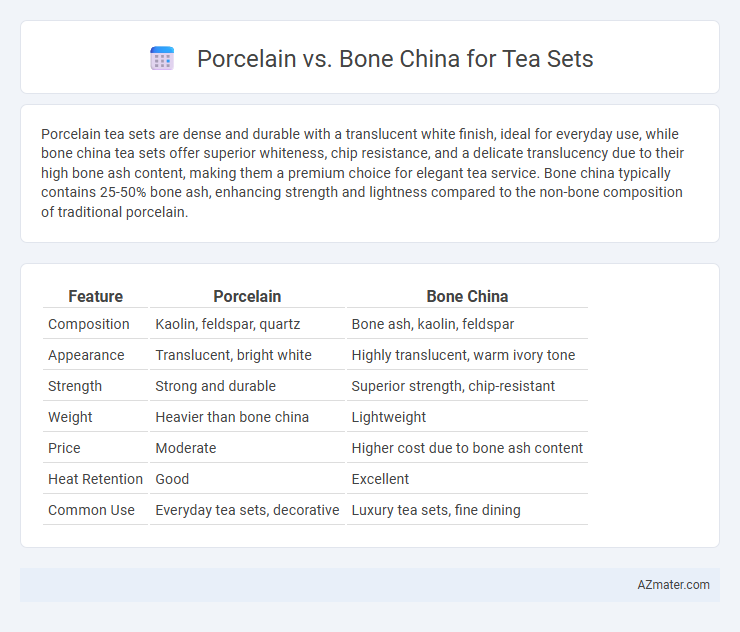Porcelain tea sets are dense and durable with a translucent white finish, ideal for everyday use, while bone china tea sets offer superior whiteness, chip resistance, and a delicate translucency due to their high bone ash content, making them a premium choice for elegant tea service. Bone china typically contains 25-50% bone ash, enhancing strength and lightness compared to the non-bone composition of traditional porcelain.
Table of Comparison
| Feature | Porcelain | Bone China |
|---|---|---|
| Composition | Kaolin, feldspar, quartz | Bone ash, kaolin, feldspar |
| Appearance | Translucent, bright white | Highly translucent, warm ivory tone |
| Strength | Strong and durable | Superior strength, chip-resistant |
| Weight | Heavier than bone china | Lightweight |
| Price | Moderate | Higher cost due to bone ash content |
| Heat Retention | Good | Excellent |
| Common Use | Everyday tea sets, decorative | Luxury tea sets, fine dining |
Introduction to Porcelain and Bone China
Porcelain tea sets are crafted from fine clay fired at high temperatures, resulting in a durable, translucent material known for its smooth finish and strength. Bone china incorporates bone ash into the porcelain mixture, enhancing whiteness, translucency, and chip resistance while maintaining lightweight properties. Both materials offer elegant aesthetics, but bone china is prized for its superior strength and delicate appearance in tea settings.
Origins and History
Porcelain originated during the Tang Dynasty in China around the 7th century, known for its high-fired clay that produces a translucent, durable material ideal for tea sets. Bone china, developed in England in the 18th century, incorporates bone ash into porcelain for enhanced whiteness and strength, becoming a luxurious choice for tea ware. Both materials reflect cultural heritage and technological advancements in ceramic craftsmanship, influencing tea traditions worldwide.
Material Composition
Porcelain tea sets are crafted from kaolin, feldspar, and quartz, offering a dense and durable material with a smooth, glass-like finish. Bone china incorporates bone ash along with kaolin and feldspar, resulting in a lighter, more translucent tea set known for its strength and delicate appearance. The presence of bone ash in bone china enhances whiteness and chip resistance, distinguishing it significantly from traditional porcelain.
Manufacturing Process
Porcelain is crafted from a mixture of kaolin, feldspar, and quartz, fired at high temperatures around 1,200-1,400degC to achieve durability and translucency. Bone china incorporates bone ash, which is calcined animal bone, mixed with kaolin and feldspar, then fired at lower temperatures around 1,200degC, resulting in a lighter, more translucent, and stronger material. The inclusion of bone ash in bone china enhances its whiteness and strength compared to traditional porcelain, making it ideal for delicate tea sets.
Appearance and Aesthetic Differences
Porcelain tea sets boast a smooth, translucent white surface that exudes a sleek and modern elegance, while bone china features a warmer, ivory tone with a slightly softer translucency, giving it a more delicate and refined appearance. The denser composition of bone china allows for thinner, lighter pieces that often exhibit intricate, hand-painted designs with a subtle sheen. Porcelain tends to showcase bold, vibrant patterns, enhancing its contemporary aesthetic, whereas bone china's creamy texture emphasizes timeless sophistication and luxury.
Durability and Strength Comparison
Porcelain tea sets offer excellent durability due to their high firing temperatures, resulting in a dense, non-porous material resistant to chipping and cracking. Bone china, containing bone ash, combines strength with translucency, providing superior mechanical strength and chip resistance compared to traditional porcelain. The inclusion of bone ash enhances bone china's toughness, making it a preferred choice for long-lasting, elegant tea sets.
Weight and Feel in Hand
Porcelain tea sets are typically lighter and thinner, offering a delicate and smooth feel in hand that enhances the drinking experience. Bone china, made with bone ash, has a slightly heavier weight and denser texture, providing a more substantial and luxurious sensation while maintaining translucency. The choice between porcelain and bone china often depends on preference for either a lightweight elegance or a solid, premium feel.
Heat Retention and Tea Flavor
Bone china offers superior heat retention compared to porcelain due to its higher calcium phosphate content and thinner construction, which helps maintain the optimal temperature of tea for longer periods. Porcelain, while elegant and durable, tends to cool tea faster because of its denser structure and lower thermal insulation properties. Tea flavor benefits from bone china's ability to preserve warmth, enhancing the infusion process and allowing subtle tea notes to develop more fully than when served in porcelain cups.
Price Range and Value
Porcelain tea sets typically offer a more affordable price range, making them accessible for everyday use and casual tea drinkers. Bone china, known for its higher durability and translucency, usually comes with a premium price reflecting its craftsmanship and calcium phosphate content. Investing in bone china can provide better value over time due to its strength and elegant appearance, ideal for special occasions and collectors.
Choosing the Right Tea Set for You
Porcelain tea sets are prized for their durability and resistance to chipping, featuring a smooth, translucent finish ideal for everyday use and modern aesthetics. Bone china tea sets offer exceptional whiteness and a delicate, lightweight feel with added strength from bone ash, making them perfect for formal occasions and collectors. Choosing the right tea set depends on your preference for durability versus elegance, usage frequency, and the desired visual impact in your tea experience.

Infographic: Porcelain vs Bone China for Tea Set
 azmater.com
azmater.com